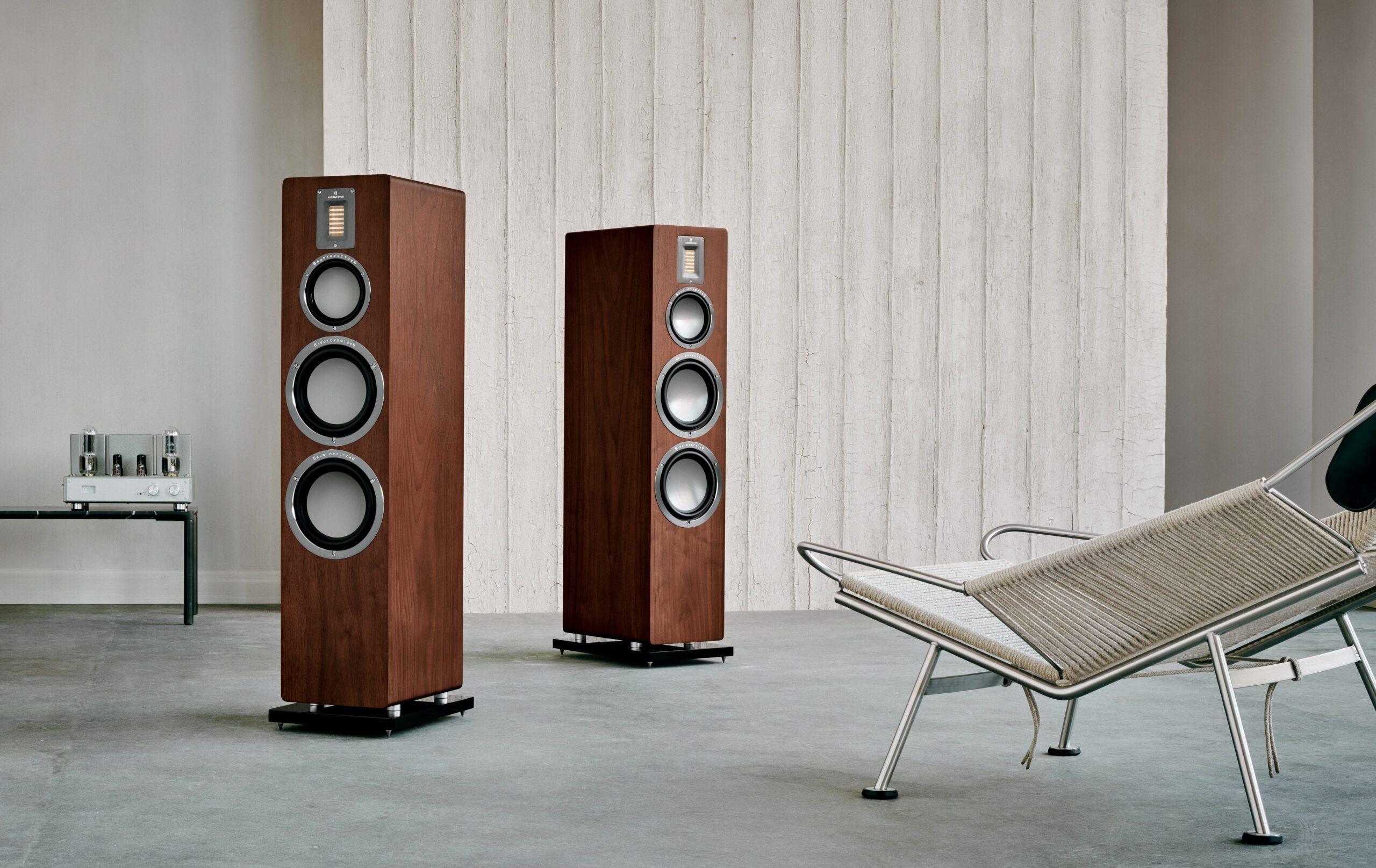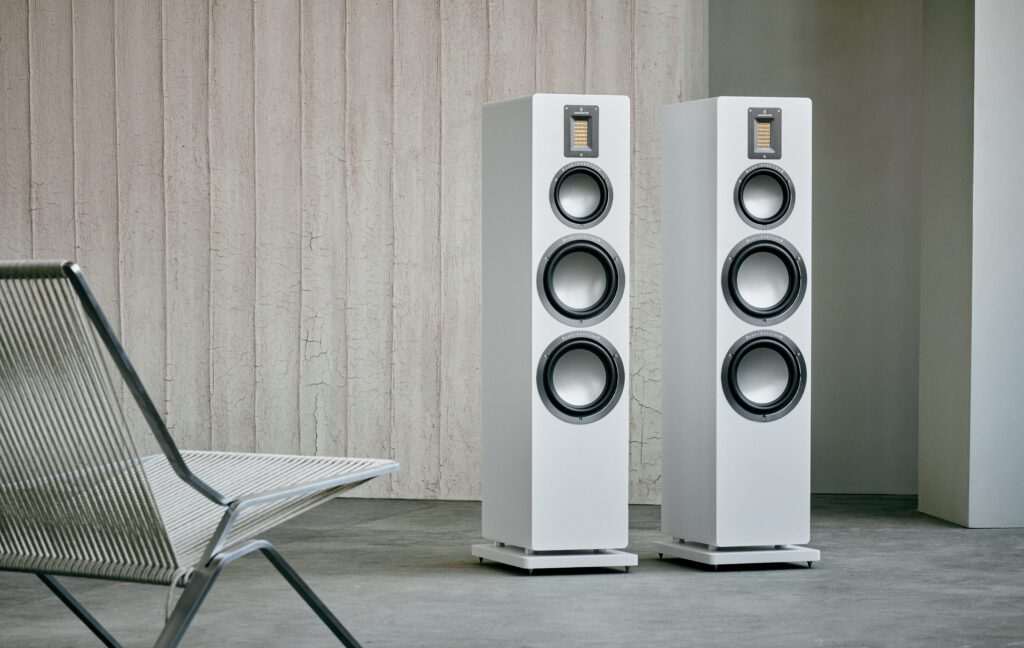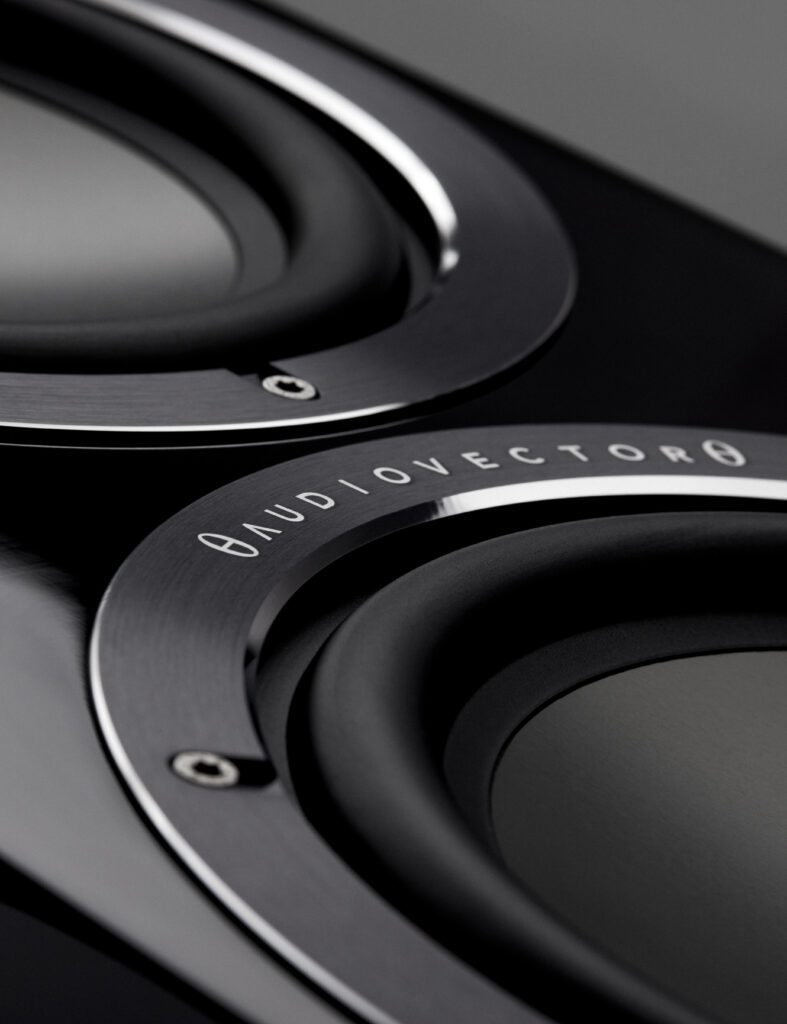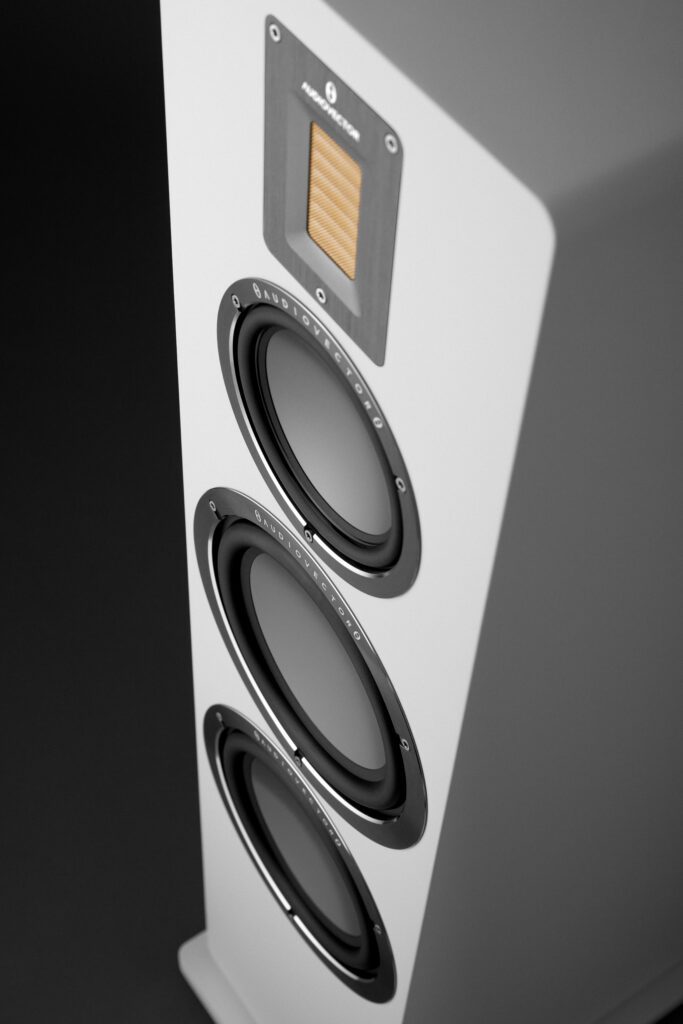
Audiovector is a clever company. It has two main loudspeaker brands. The R-Series is its classic, upgradable premium range that runs from a small but superb two-way stand-mount called the R1 up to the super high-end R11 floorstanding tower of power. Alongside this are the ever-growing QR-Series, of which the QR 7 is the latest, greatest, and certainly the largest of them all.

Now comprising a stand-mount, three floorstanders, a centre channel, a subwoofer and wall mounts for home cinema use, the QR series is the entry-level range for Audiovector. However, that doesn’t mean ‘built half a world away’; the speakers are built alongside the R models in Denmark at the company’s Copenhagen facility. Like all the models in Audiovector’s range (and almost all loudspeaker designs around the world), the cabinets are sourced externally, and the entire QR range (except the sub) features an Air Motion Transformer ‘Gold Leaf’ planar magnetic tweeter in place of the more commonplace fabric or metal dome designs.
Higher than you think
The use of an Air Motion Transformer tweeter is an upgrade for traditional Audiovector designs. It doesn’t come as standard with the Signature models but is a feature of the Avantgarde and Arreté designs. However, this is not the same tweeter as used in these ‘better’ and ‘best’ variants of the company’s top line, but it’s a very close relative. The tweeter includes a mesh called an S-Stop Filter by the company. This is there to eliminate sibilants, a little like a pop filter in a recording studio.
The midrange and bass units are of an aluminium sandwich construction, comprising two layers of aluminium with a filling of mystery-damping material… but no lettuce or mayo. This is a construction technique relatively new to Audiovector that only appears across the QR-Series. Previous cones in R-Series designs are more traditional. These are also ‘Pure Piston’ cones, which means they don’t have the same break-up modes as other metal-cone drivers. There’s a similarity between this driver design and those used both by ELAC and Monitor Audio.

The cabinet is clever, too. Internally, it has a sealed midrange enclosure within the main body of the loudspeaker. This cabinet-within-a-cabinet is also asymmetric to reduce significantly any internal standing wave problems.
The QR 7 also uses a ‘Q-Port’ design. This is a downward firing port at the front of the base of the cabinet that sends bass into the loudspeaker’s plinth. This makes the speakers relatively easy to rough/first-fit install, although they benefit greatly from a lot of fine-tuning. The front-ish down-firing port does make the QR 7 a little less sensitive to the distance to the wall.
Big is beautiful
The cabinet is a big ‘un. Standing some 114cm tall and 40cm deep and weighing in at a ‘frisky’ 36.2kg per speaker, this is a physically large speaker from what is otherwise a range of very metropolitan-chummy designs. It’s perfectly proportioned (the 25cm front baffle and 2x 203mm bass units look perfectly ‘right’ in context), but it’s big… and requires a big room too. Where the other models in the QR-Series are less sensitive to room dimensions and positioning, those twin eight-inch drivers move a lot of air in a small-to-medium room that will sound too powerful and set that room off.
I don’t want to overstate this room size demand, but neither should it be brushed under the carpet. The QR 7 doesn’t put so much energy in the room that string quartets sound like Deadmau5 has remixed them, but the QR 7s are a lot happier in a room 5x6m or greater, preferably with at least 2.5m high ceilings.
I think this sizing point is a feather in the QR 7’s cap. Often, those trying to fill a big room are a little stuck, which is the polite way of saying ‘completely screwed’. You see, affordable audiophile-grade loudspeakers generally expect relatively small room dimensions. Those with bigger spaces to fill are either pointed toward far bigger and WAY more expensive loudspeaker designs, force-extolled the virtues of bass lightness, or dismissed out of hand. The QR 7 fills a big room well, with all the audiophile credentials you need, but without being either too fussy about music (or partnering equipment) or ending up costing a King’s Ransom.

I have to put my hand up to being just as guilty as everyone else in this, thinking that if someone has a room 4x5m or larger, they have a willingness and ability to use £30,000 worth of loudspeakers to bring it to life. QR 7 shows there is an alternative.
Mads in Munich
Like most, our first experience of the QR 7 was in Munich. Audiovector CEO Mads Klifoth was an exceptionally happy man at the show; his wife had just given birth to their second child, and he had a hit on his hands with the QR 7. He knew he had a hit in the QR 7 because show-goers kept coming back to the room, and they stayed in the room longer than usual. Given the room was one of the glass-roofed ones on the top floor of the MOC in sweltering (for May) heat, people actively spending time in the room and coming back time and again marked the QR 7 out as something special. I was one of those regular returnees and placed our order for a review sample.
Little did we know at the time that the whole world was doing the same thing! The QR 7 became the hot product of the show; everyone on the planet wanted a pair, distributors and dealers were almost willing to engage in war crimes to get a pair, and our “yeah, we should be able to ship a pair to you in a couple of weeks” got a lot of pushback. And when you see them in the flesh, it’s not hard to see why. They are extremely well-proportioned loudspeakers that (in context) do not look as physically imposing as other similarly sized designs. The finish (ours came in White Silk) is excellent; the whole package feels reassuringly weighty and well-balanced, both physically and aesthetically.
Partnering is relatively easy. The QR 7 is a benign six-ohm load with a 90.5dB sensitivity meaning you don’t need a behemoth amp to drive them. And, although they benefit from some quality audio upstream, the QR 7 has enough of the QR DNA to make it sound good when intelligently – rather than ‘expensively’ – amplified. Careful installation and paying special attention to toe-in, speaker levelling, and in particular, listener height relative to the tweeters yields far bigger results in terms of performance upgrades.
Running in
The loudspeakers also benefit from several dozen hours of breaking in. They don’t change substantially tonally, but you might want to revisit the set-up after some bedding in and loosening up to see if the positioning has changed slightly.
All this is worth the effort, though, because the sound you get out of the QR 7s is beyond excellent… and beyond expectations. Of course, it’s the bass that calls loudest first; the QR 7 has a powerful yet precise bass that doesn’t have any undue emphasis down into the low registers. There’s a delicate balance here between audiophile sensitivities (who are unwilling to put up with too much bass) and those of the mainstream (who are unlikely to stand too little). I think Audiovector treads the right path. It’s deep enough to make King Tubby records rattle fillings and loosen bowels but not so overpowered that it will do the same at the first scrape of a cello.
What happens in the bass is echoed up the frequency response, and the QR 7 is a keen and dynamic-sounding loudspeaker. And I mean proper balls-to-the-wall dynamics, the kind of thing that makes you want to play ‘The Dreary Falls’ from Blackwater Path by Opeth [Music for Nations] at neighbour-scaring levels, enjoying the soft acoustic guitar moments cut with a lot of graunch and prog-metal pomp and some fine growling too. It’s a forward, dynamic and incredibly detailed record that is a perfect match for similar qualities in the QR 7.
One of the traditional problems with using two very different types of loudspeakers for mid/woofers and tweeters is the risk of lack of coherence or even a discontinuity between the two. Fortunately, Audiovector has spent a long time dealing with AMT drivers, and that step change from cone to the planar driver is handled well. It helps that the speed of the bass and midrange can keep up with the AMT unit, making for an almost preternaturally fast loudspeaker that knows its way around a drum kit. I’m all about Ringo Reputation Rehabilitation, and far from ‘not even being the best drummer in the Beatles’ his swampy wander around the drum kit on ‘Come Together’ [Abbey Road, Apple] is perfectly rendered, which takes a loudspeaker fast enough to process his rapid hi-hat hits, deep enough to play those kick drum hits and accurately play those backward tom-tom triplets through the midband. Get it wrong, and it sounds like two drummers or just a right-handed drummer playing the tom-toms; the QR 7 makes it abundantly clear he’s a left-handed drummer. It’s those little things that mount up and make for a great-sounding loudspeaker.

Although I’ve been primarily discussing rock music, the QR 7 doesn’t differentiate. It’s just as adept at playing jazz, folk, world or classical music. And all the usual acid tests of musical replay are dealt with extremely well here; whether it’s Joyce DiDonato’s powerful voice, deep electronica notes, or a delicate Bach invention, the balance is the same; slightly forward, precise, tonally accurate, dynamic and with an extended frequency range.
Imaging is good too. I use Audiovector’s R1 Arreté loudspeakers as a part of my arsenal – which, compared to the QR 7, trade bass depth for a holographic soundstage – but there is still a strong sense of three-dimensionality to the sound. Images are wide of the speakers (again calling on a big room, as they need side wall space) with a combination of a good sense of space around individual instruments and a fine and rooted sense of solidity to those instruments and the musicians behind them. You get a feeling of real humans playing music with the QR 7.
Easy and ad hoc
There are a couple of easy, ad hoc ways of determining the quality of a loudspeaker; would you be happy recommending it to a close friend or relative (or at least a relative you like)? The answer here is a resounding ‘yes’! How much more would you have to pay for another loudspeaker and the rest of the system to improve? And here, the answer is ‘lots’; you’d be looking at a high-end speaker system and some really ‘spendy’ electronics to get close to what the QR 7 can do in a big room.
The Audiovector QR 7 fills something of a gaping hole in the loudspeaker market; the good, big speaker without a great big price tag. We metropolitan types often forget that many are fortunate to have big rooms to fill with sound, but not all have big money to spend to do so. Sure, it’s relatively easy to find something that’s compromised in one way or another but finding a loudspeaker that doesn’t compromise in this setting is a true joy.
Technical specifications
- Type: 3-way, four-driver, floorstanding speaker with AMT tweeter
- Drivers: One AMT ribbon tweeter; one 6in. Pure Piston midrange driver; two 8in. Pure Piston bass drivers
- Crossover frequencies: 425Hz, 3kHz
- Frequency response: 28Hz–52kHz
- Impedance: 6 Ohms
- Sensitivity: 90.5dB/W/m
- Dimensions (H×W×D): 1140 × 25 × 40cm
- Weight: 36.2kg/each
- Finishes: Black piano, dark walnut veneer, white silks.
- Price: £ 4,950/pair
Manufacturer
Audiovector
UK Distributor
Renaissance Audio
+44(0)131 555 3922
By Alan Sircom
More articles from this authorRead Next From Review
See all
Reiki Audio SuperSwitch Master Pro + Servant Pro
- Mar 27, 2024

Melco Audio N1-S38 music server
- Mar 27, 2024

Focal Utopia 2022 headphones
- Mar 27, 2024











